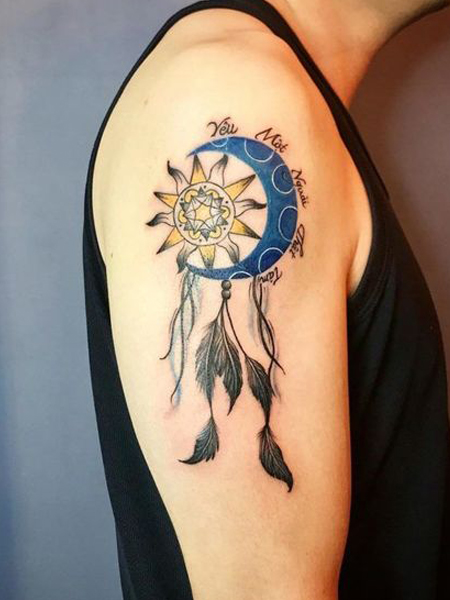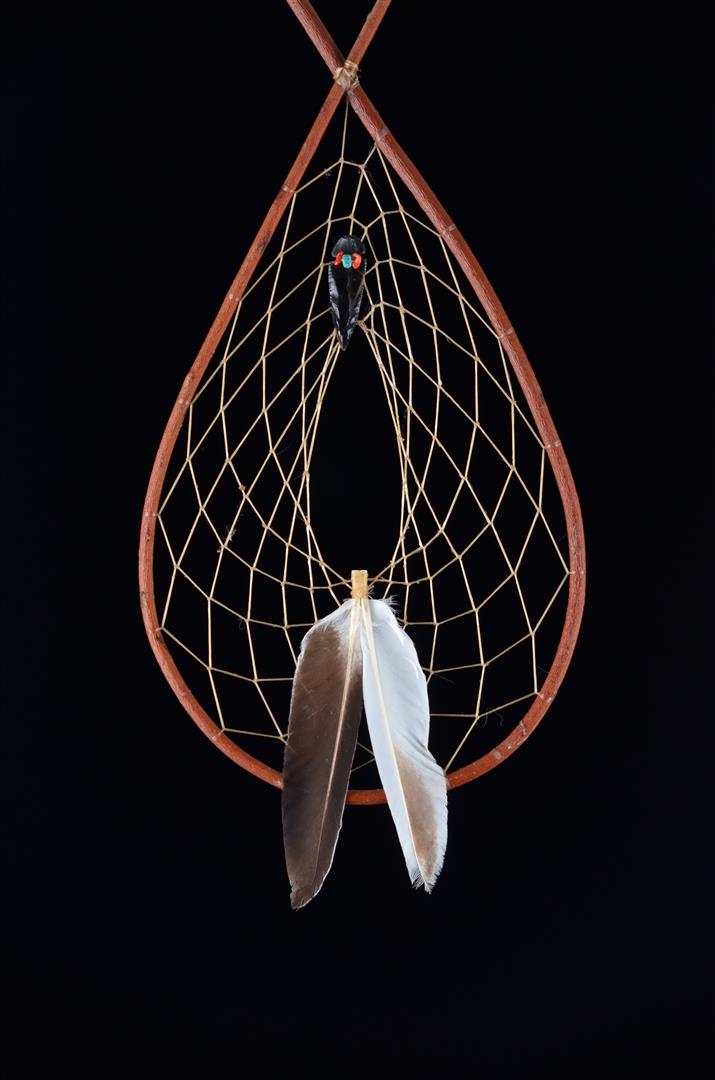The Dream Catcher
The dream catcher is most commonly associated with Native American culture. Originating from the Ojibwe people, who lived primarily in the northern USA and Canada, the dream catcher shares a story that bends the the seams between dreams and reality.
- Dreamcatcher Meaning And Magic. Powerful magic happens when a dream catcher is hand-made with the intent of protection and love by the mother of the child for whom the dream catcher will belong. The father of the child hangs the dream catcher from the ceiling low enough that the sunlight hits the dreamcatcher in the morning. This is important.
- In some Native American and First Nations cultures, a dreamcatcher or dream catcher (Ojibwe: asabikeshiinh, the inanimate form of the word for 'spider') is a handmade willow hoop, on which is woven a net or web. The dreamcatcher may also include sacred items such as certain feathers or beads.
Nowadays often seen in souvenir and gift shops or hanging off a bedroom wall, these handcrafted trinkets typically consist of a round, woven net of various fiber or red willow, and adorned with feathers, leather, beads, or various other materials differentiating from tribe to tribe.
The Ojibwe Dream Catcher Legend
The Ojibwe word for a dream catcher is ‘asabikeshiinh’. This term is the inanimate word for ‘spider’. According to American ethnographer ‘Frances Densmore‘, the origin of the dream catcher lies in a folktale of the Asibikaashi. The Asibikaashi were believed to be a type of human and spider hybrid, who along with Wanabozhoo, brought the sun to the people of the land.
After this, they became caretakers of the children, the tribe, and the land. The story goes on to say that as the Ojibwe tribe began to occupy more territory it became more taxing for the Asibikaashi to tend to all the land. This led to the tribal women spinning web shaped ornaments out of willow, sinew or cord to give to children and infants as protective charms. It was thought that these charms would catch any evil, or bad dreams that might be in the air, similar to how a spider web catches whatever flies into it.
The Lakota Dream Catcher Legend
Parental Guidance:Some material of this video may not be suitable for children below 13 years of age. The Dreamcatchers Story in English Story English St.

Long ago, when the world was young, an old Lakota spiritual leader was on a high mountain. On the mountain, he had a vision. In his vision, Iktomi – the great trickster and teacher of wisdom – appeared in the form of a spider.
Iktomi spoke to him in a sacred language. Only spiritual leaders of the Lakota could understand. As Iktomi spoke, he took the elder’s willow hoop – which had feathers, horse hair, beads and offerings on it – and began to spin a web.
He spoke to the elder about the cycles of life and how we begin our lives as infants. We then move on to childhood and in to adulthood. Finally, we go to old age where we must be taken care of as infants, thus, completing the cycle.
“But,” Iktomi said as he continued to spin his web, “in each time of life there are many forces – some good and some bad. If you listen to the good forces, they will steer you in the right direction. But, if you listen to the bad forces, they will hurt you and steer you in the wrong direction.”
He continued, “There are many forces and different directions that can help or interfere with the harmony of nature and also with the Great Spirit and all of his wonderful teachings.”
All while the spider spoke, he continued to weave his web … starting from the outside and working toward the center. When Iktomi finished speaking, he gave the Lakota elder the web and said, “See, the web is a perfect circle, but there is a hole in the center of the circle.”
“Use the web to help yourself and your people … to reach your goals and make use of your people’s ideas, dreams and visions. If you believe in the Great Spirit, the web will catch your good ideas, and the bad ones will go through the hole.” (Note: Some bands believe the bad ideas are caught in the web and the good ideas pass through to the individual. Either account is acceptable.)
The Lakota elder passed his vision on to his people. Now, the Sioux use the dream catchers as the web of their life. Traditionally, it is hung above their beds or in their homes to sift their dreams and visions. Good dreams are captured in the web of life and carried with them … but the evil dreams escape through the center’s hole and are no longer part of them. (Note: Some bands believe the bad ideas are caught in the web and the good ideas pass through to the individual. Either account is acceptable.)
Lakota believe the dreamcatcher holds the destiny of their future.
A dream catcher is pretty self-explanatory, right? Yep, you’d be correct in thinking that dream catchers are made to snatch away bad dreams… but there’s so much more to them than that.
These beautiful Native American talismans have a rich history, steeped in tradition. They’re not just eye-catching displays in cheap gift stores!
Anyone who has a dream catcher or wants to buy one should read this article first. You need to know the true meaning of dream catchers to respect and admire the culture behind them.
What is a Dream Catcher?
Just in case you’re really clueless, a dream catcher is a small round talisman that’s hung by your bed to capture bad dreams and/or deliver good dreams and thoughts while you sleep.
Traditional, authentic dream catchers were made from wooden hoops, with thread webbing, handmade beads, leather, and feathers. Organic, natural materials are essential. They would be a few inches wide at most, and certainly wouldn’t be the bright, colorful and over-the-top dream catchers you find in cheap holiday gift shops.
The huge, plastic dream catchers with vividly bright faux feathers are a commercialized version of the original Native American dream catcher – more on why you shouldn’t buy these below.

How the traditional dreamcatcher works varies slightly from one legend to another, but the meaning is always similar: to catch harmful thoughts or bad dreams and keep you safe with good dreams and positive thoughts while you sleep. Dream catchers were originally made for very small children and babies, so they could be hung just above their cribs.
Over the decades, dream catchers have taken on new meanings – some with respect for the traditions, others without – and become symbols for various movements, such as the non-violent Pan-Indianism Movement.
The Beautiful Legends Behind Dream Catchers
Various Native American cultures have dream catchers, or a version of them, woven into their traditions. But it is the Ojibwe culture (indigenous people originally from northern midwestern USA and Canada) that the majority of historians agree the dream catcher originated from.
The legend focuses on Asibikaashi, the spider woman. She was the spiritual protector of the Ojibwe people, protecting the children from harm.
As their people spread further across the land, Asibikaashi found it harder to protect everyone from far away. So, the dream catcher was created.
The web within the willow hoop, like a spider’s web, would catch any bad thoughts or spirits lingering around – not specifically for bad dreams.
From here, the legend branches out with different meanings and stories depending on who’s telling the history of dream catchers.
Many believe that the dreamcatcher will catch bad dreams in the web, while good dreams filter through the hole, gem or bead in the center. When the first rays of the sun touch the dreamcatcher in the morning, those trapped bad dreams are destroyed.
Lakota Legends
Similarly to Ojibwe, the Lakota legends about dreamcatchers begin with a spiritual being associated with spiders. Iktomi created the dreamcatcher to catch good ideas on the web so they won’t be lost, but let bad ideas filter through the central hole and simply pass by their people unharmed.
The dreamcatcher itself is also a symbol – the perfectly round hoop is a symbol of the circle of life, the sun, and the moon. The soft, downy feathers (often owl feathers) are the ladders that good dreams float down into your mind.
Furthermore, the number of points where the webbed thread touches the inside of the hoop is symbolic. 13 points represent the phases of the moon, 8 for the spider woman’s legs, 7 for the prophesies, 6 for the eagle, and 5 for a star.
Sacred beads and tokens can also be added amongst the feathers.
The Dream Catcher Langston Hughes

Finally, the gems or stones in the dreamcatcher can represent good dreams or, if there’s a single stone, represent the creator of the world.
Why Understanding the Symbolism and History of Dream Catchers is Important
Dreamcatchers are closely tied to heart-warming and noble legends of Native Americans – so is it right for people around the world to buy dreamcatchers on a whim or simply because they’re “pretty”?
The dreamcatcher should be a symbol of unity among Native American communities, not an over-commercialized and misused plastic decoration, made in China, and eventually forgotten in a landfill site.
This is where cultural appropriation comes in. It is controversial, and frankly offensive in our opinion, to adopt a piece of tradition from one culture without even trying to understand and respect the origins and meaning behind it.
Cultural appreciation, on the other hand, should be commended. Owning a dreamcatcher, understanding and respecting the meaning behind it, and supporting the Native American people is to be commended.
That’s why we recommend you buy dreamcatchers from traditional Native American craftspeople – you’ll find them for sale in Indian territory across the US and Canada, just look for tribal giftshops or attend Native Indian events to learn more about the culture as well.
For online resources to buy authentic dreamcatchers from, check out this list from Native Languages.

Gifting dreamcatchers to newly born babies and young children is a beautiful way to honor the original dream catcher meaning and respect the legends behind them by passing down the story from one generation to the next.
Summary – Dream Catcher Meaning
If you’ve been looking for a scientific explanation of how dreamcatchers work, you’re going to be disappointed. Dream catchers are stunning talismans with a beautiful history and meaning behind them.
The Dream Catcher Book
The simple act of respecting and honoring the tradition of your dreamcatcher as you hang it above your bed is sure to leave you with a smile on your face and good dreams in your mind!
If you want to buy a dream catcher, you can check the best seller from Amazon, Walmart and even Aliexpress (very cheap)
The Dream Catcher Antiques & Collectibles
Just remember to:
The Dream Catcher 1999
- Learn about the dreamcatcher you’re buying, and the symbolism behind it.
- Respect and appreciate the culture that brought you the dream catcher.
- Buy traditional, hand-crafted dreamcatchers from Native American craftspeople.